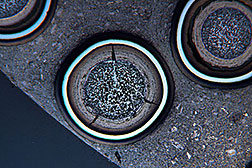- Number 407 |
- February 17, 2014
Idaho scientists discover clue in the case of the missing silver

Micrograph of an irradiated fuel pellet
containing TRISO particles, which have
layers of carbon and carbide that serve as
the primary containment for radioactive
material.
A safer, next-generation fuel is on its way. Scientists at DOE's Idaho National Laboratory recently found the location of silver precipitate in tristructural-isotopic (TRISO) fuel particles, a key in ensuring safe use of the fuel.
The poppy-seed-sized TRISO particles consist of a uranium center, coated by a layer of silicon carbide and a layer of carbon. These layers are meant to contain the radioactive products of fission, which includes little bits of silver. Sometimes (1-2 percent of particles) silver fission products escape from the center and can even escape the particle entirely. How this happens was mystery spanning 40 years.
Then an INL research team lead by scientist Isabella Van Rooyen wondered if the escape path involved the networks where each layer of the TRISO particle meets the next and where the grains that make up the layers themselves align with each other. To investigate, they used a Scanning Transmission Electron Microscope in the Materials and Characterization Suite at the Center for Advanced Energy Studies at INL.
Sure enough, the researchers located silver along the grain boundaries of two layers of TRISO coating. Next, the scientists will test their theory that silver can escape by traveling along these boundaries.[Teri Ehresman, 208.526.7785,
teri.ehresman@inl.gov]
